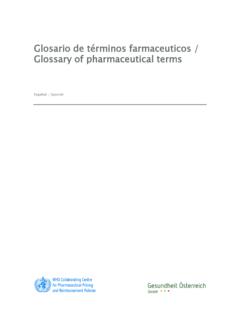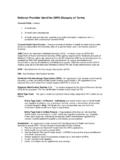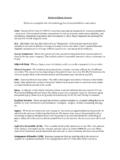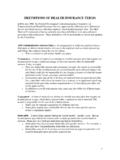Transcription of Glossary of Pharmaceutical Terms - goeg.at
1 WHO Collaborating Centre for Pharmaceutical Pricing and Reimbursement Policies Glossary of Pharmaceutical Terms Update: 2013 WHO Collaborating Centre for Pharmaceutical Pricing and Reimbursement PoliciesGlossary of the WHO Collaborating Centre for Pharmaceutical Pricing and Reimbursement Policies Update: 2013 Authors: Sabine Vogler Nina Zimmermann Supported by: Christine Leopold Bettina Schmickl In coordination with the Pharmaceutical Pricing and Reimbursement Information (PPRI) network and the World Health Organization (WHO) Project Assistant: Romana Landauer Vienna, November 2013 Owner and Editor: Gesundheit sterreich GmbH, Stubenring 6, A-1010 Vienna, Phone +43 1 515 61, Fax 513 84 72, Homepage: For our enviroment: This report has been printed on paper produced without chlorine bleaching and optical brighteners.
2 III Introduction When communicating in any field, a common understanding is of major importance. All people involved in providing and/or addressed with information no matter if they are experts or lay persons need to understand the underlying concepts and notions in that field. This is a major lesson learned from the PPRI ( Pharmaceutical Pricing and Reimbursement Information) project (for further information on PPRI see below). Based on the observations about misunderstandings among the PPRI network members, all of them experts, the PPRI secretariat decided to establish a Glossary which was mandatory for the PPRI network members when they wrote the PPRI Pharma Profiles.
3 The first version of the PPRI Glossary was drafted, revised after a consultation process with the PPRI network and published in 2006. Since terminology is constantly changing, the authors of the PPRI Glossary invited experts and the public to provide feed-back on the Glossary , make suggestions for changes and propose new Terms . A major revision was done via the PHIS Glossary in the course of the EC co-funded project PHIS ( Pharmaceutical Health Information System, see below). The PHIS Glossary was produced under the lead of the Italian Medicines Agency AIFA together with Gesundheit sterreich GmbH / Gesch ftsbereich BIG (Austrian Health Institute) and after feed-back of the PHIS network (European competent authorities for Pharmaceutical pricing and reimbursement, hospital pharmacists) and the PHIS Advisory Board.
4 This PHIS Glossary particularly aimed to incorporate Pharmaceutical policy-related Terms with regard to the in-patient sector. Further major revisions followed in April 2011 and in October 2012 which resulted in new versions of the Glossary . In addition to regular updates and revision of the Glossary , the WHO Collaborating Centre for Pharmaceutical Pricing and Reimbursement Policies is committed to disseminating the Glossary : We believe that the tool of a Glossary can contribute to an improved joint understanding. Furthermore, to support clarity on terminology, glossaries in national languages are being produced; a German and a Spanish Glossary are already available.
5 The current Glossary on Pharmaceutical Terms of the WHO Collaborating Centre of Pharmaceutical Pricing and Reimbursement Policies is available as a full text document and in an online searchable version, both of them accessible at the website Glossary . IV PPRI, PHIS, and WHO Collaborating Centre Pharmaceutical Pricing and Reimbursement Information (PPRI) started as a research project, co-funded by the European Commission, Directorate-General Public Health and Consumers. It was carried out from 2005 till early 2008. In the course of the project the PPRI network was established, and a set of Pharmaceutical indicators, filled with real data from 27 PPRI countries, as well as more than 20 country reports (PPRI Pharma Profiles) and brief overviews on the Pharmaceutical systems (country information) were produced.
6 Today, Pharmaceutical Pricing and Reimbursement Information (PPRI) is a networking and information-sharing initiative on urgent issues of Pharmaceutical policies from a public health perspective. The PPRI network involves representatives from around 70 institutions: These are public authorities and third party payers from 41 countries (mainly European countries, including all 28 EU Member States) as well as European and international institutions such as European Commission services and agencies, OECD, WHO (HQ and Regional Office for Europe) and the World Bank. In the on-going PPRI initiative, the networking of the public authorities continues via regular networking meetings and continuous sharing of relevant information for decision-making, including up-dates of country-specific information.
7 The PPRI secretariat is hosted at the WHO Collaborating Centre for Pharmaceutical Pricing and Reimbursement Policies. The PPRI project was selected by the Executive Agency for Health and Consumers, in collaboration with the Health Programme s National Focal Points (NFP) and the Directorate General for Health and Consumers (DG SANCO), as a good practice example of EU Public Health projects with an important impact for EU Member States. The Pharmaceutical Health Information System (PHIS) was a European Commission co-funded project which ran from September 2008 to April 2011. The project aimed to increase knowledge and exchange of information on Pharmaceutical policies, in particular on pricing and reimbursement, in the EU Member States, covering both the out-patient and the in-patient sectors.
8 A special focus of the project was on medicines in the in-patient sector, with a European survey of medicines management in hospitals in the EU Member States and an investigation and analysis of official and actual prices of medicines in hospitals in selected countries. Methodology tools, in particular with regard to terminology, indicators and reporting tools, have been further developed based on work started in PPRI. The Health Economics Department of the Austrian Health Institute was nominated as WHO Collaborating Centre for Pharmaceutical Pricing and Reimbursement Policies in the summer of 2010. The Centre has been continuing methodology work started under V the framework of the PPRI and PHIS projects: One of the Centre s explicit tasks is to develop a tool for describing and analyzing national Pharmaceutical pricing and reimbursement systems ( Pharma Profiles ).
9 WHO Collaborating Centre staff were also involved as experts in the development of the revised WHO Pharmaceutical Country Profiles by helping to expand the current tool of the PPRI/PHIS Pharma Profiles for the European countries, and adapting it so that it can describe the Pharmaceutical sector in other health system arrangements. Within the PPRI and PHIS projects, websites were established. Policy makers, researchers and the interested public are offered free access to our findings and the methodological tools developed. Though the PPRI and PHIS project websites are no longer maintained all relevant PPRI and PHIS information was integrated into the website of the WHO Collaborating Centre for Pharmaceutical Pricing and Reimbursement Policies established in 2010: The website of the Centre is designed to serve as an information platform about Pharmaceutical policies, and it provides published profiles, indicators of the PHIS database, glossaries and templates for reporting of Pharmaceutical pricing and reimbursement information.
10 Contact For queries, feed-back and suggestions for modifications, deletions and new Terms : WHO Collaborating Centre for Pharmaceutical Pricing and Reimbursement Policies Sabine Vogler, Nina Zimmermann e-mail: Recommended citation: WHO Collaborating Centre for Pharmaceutical Pricing and Reimbursement Policies. Glossary of Pharmaceutical Terms . Update 2013. Accessible at WHO Collaborating Centre, G G/ BIG, Glossary 2013 1 ABC Analysis Method by which medicines are divided, according to their annual usage (unit cost times annual consumption) into class A items (the 10 to 20 percent of items that account for 75 to 80 percent of the funds spent), class B items (with intermediate usage rates), and class C items (the vast majority of items with low individual usage, the total of which accounts for 5 to 10 percent of the funds spent).





